Samsung DA-E750 Wireless Audio Review
- Transfer
Good Friday, Khabravchians!
Today I would like to bring to your attention an overview of the new Samsung DA-E750 wireless audio system. The flagship novelty was studied up and down by the Korean blogger CD Man.
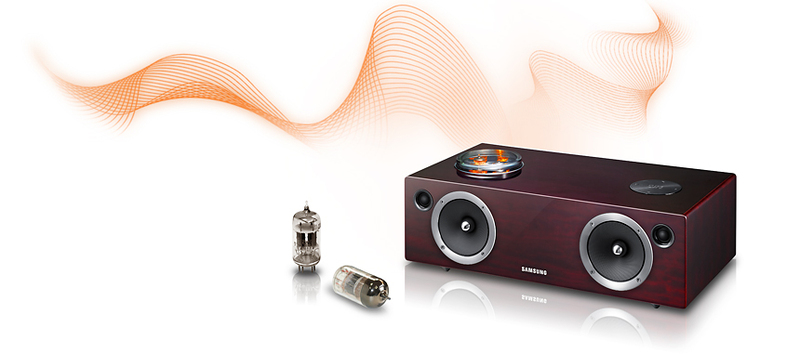
If you can relate to music lovers and audiophiles, you must have heard about the new Samsung DA-E750 audio system. This device marks Samsung’s expansion into the hi-end audio market, combining high-quality sound and aesthetically pleasing design.

DA-E750 is a wireless audio dock that is equipped with vacuum tubes and can connect to smartphones (supports iPhone, iPad, iPod and all smartphones of the GALAXY series). Being the proud owner of the GALAXY S III, I had the opportunity to connect to the dock via a Bluetooth connection. The device supports various communication interfaces, such as USB, Air Play, Allshare Play and Bluetooth, so you do not have to worry, even if your smartphone is not from the GALAXY series.
If you prefer an iPhone or iPad, you can connect them to the DA-E750 through the port or via Air Play for a wireless connection.
I want to share with you my thoughts on the new Samsung audio system, which I have carefully tested. I will talk about the strengths and weaknesses so that you can get a complete picture of what this equipment is capable of.
The DA-E750 looks like a rectangular block, with two large and two small front speakers. Through a transparent glass cover in the upper left you can see two vacuum lamps and a round control panel on the right. The weight of the device is 8.6 kg.
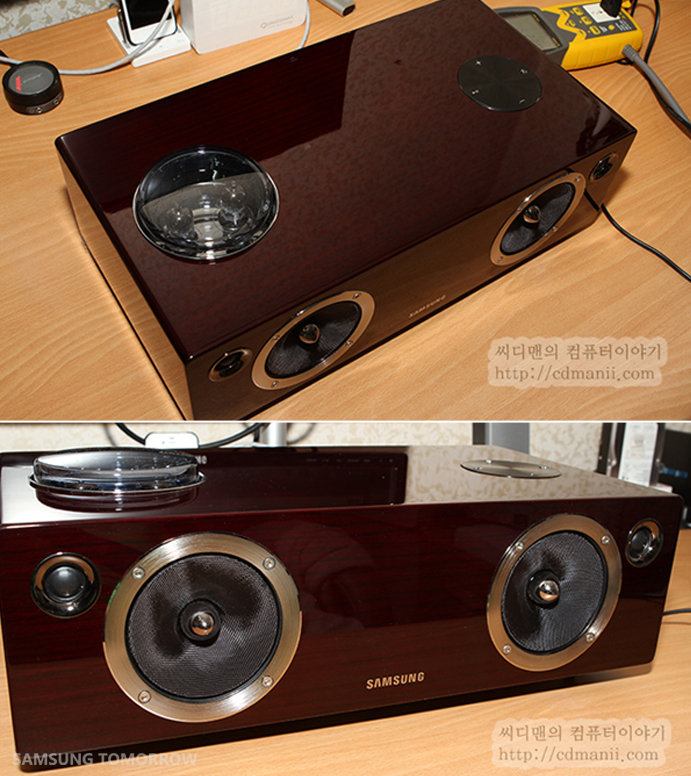
A camera flash makes the colors a little brighter than they really are, so in reality the tree has a dark reddish brown hue. The surface of the classic case is varnished and smooth.

Wanting to learn more about the audio system, I decided to check the sound quality of the dock itself.
To check the sound quality, I connected the device directly via USB, and at first the sound was not as good as I expected. For comfortable listening to music, you need not only decent speakers, but also a good sound source. But it seems that the DA-E750 needs a little time to preheat until it starts to produce the perfect sound. This happened after some time: the sound became excellent.
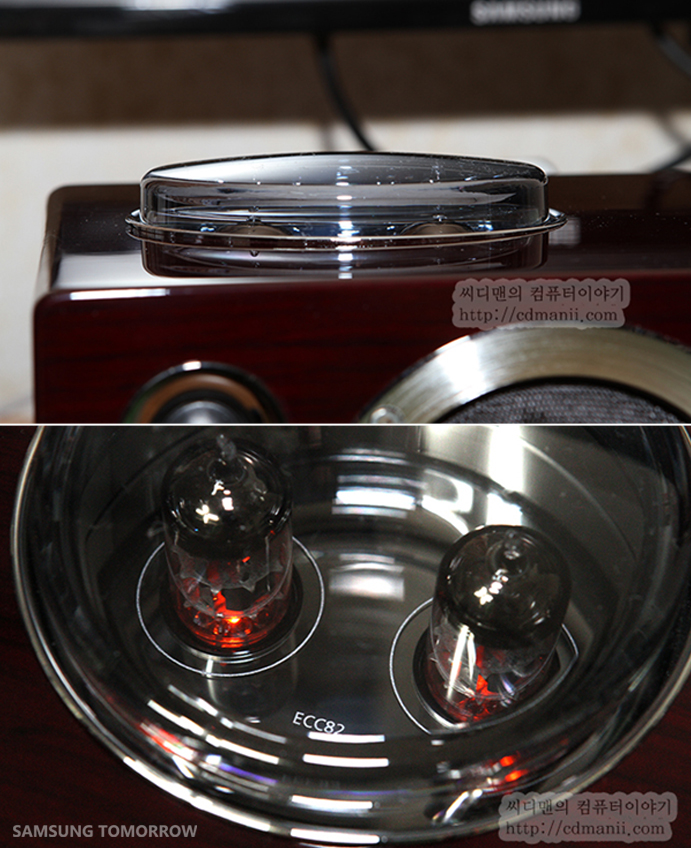
Next, I noticed the vacuum tubes at the top. When turned on, they turn red, as you can see in the photo. The input signal source is processed by a preliminary amplification stage performed on two ECC83 lamps, and then passes through a power amplifier operating in class D. It is stated that the service life of these vacuum tubes will be quite long.
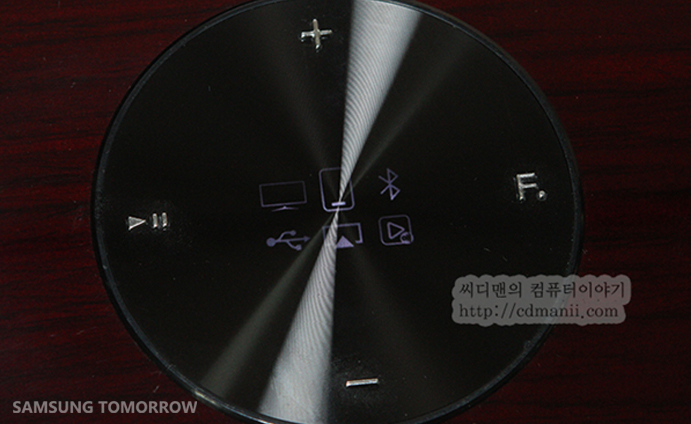
At the top left is the control panel. To show all the icons in the photo, I clicked on it. At rest, the icons do not light. Pressing the play button turns on the device, a long press on it also turns off the power. Through the panel, you can control playback, pause, volume control and a choice of functions.
A small disappointment was the fact that looking at the front panel of the system it is impossible to determine whether the device is turned on or not. I think the presence of the function to automatically turn off the dock at a time when it is inactive would be very helpful here.
In addition, the “skip to next song” function was not available on the control panel. Of course, you can use a smartphone or a remote control to select the next song, but I think it would be nice to add these buttons: not that there isn’t enough room for them. I would also like to be able to see the volume level on the device itself. I was frightened almost to hiccups when I first connected my phone to the audio system via Bluetooth. The sound just dumbfounded me, because it was initially set to maximum volume. It would not be superfluous to have an automatic reset of the playback volume the first time you turn it on.
Now let's look at the bottom of the Samsung DA-E750. This is where the subwoofer is located, as well as sharp conical legs with rubber pads.
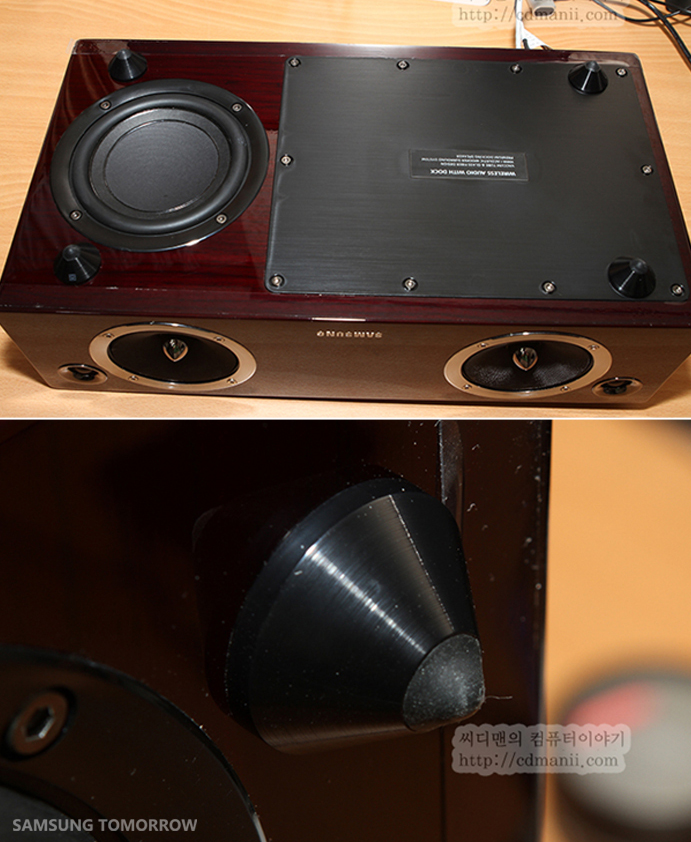
There are not many elements on the rear panel of the device, this also applies to the number of ports. The phase inverter port is displayed on the left side, the LAN port, USB port, AUX IN and various connection interfaces are on the right, and in the middle is the dock.
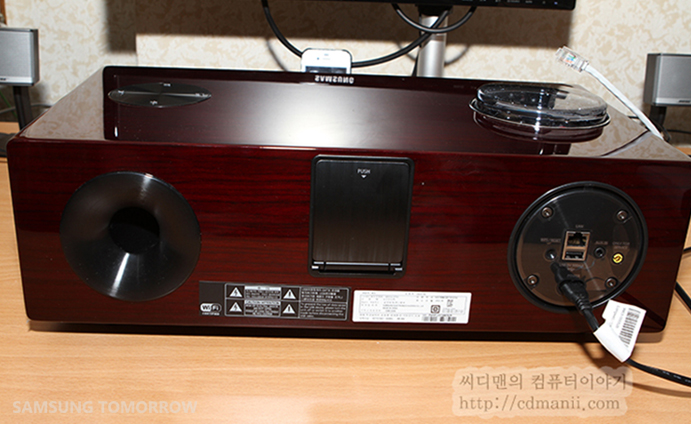
There is also a WPS / Reset button that provides a quick connection, an ONLY FOR SERVICE service port, and a power connector.
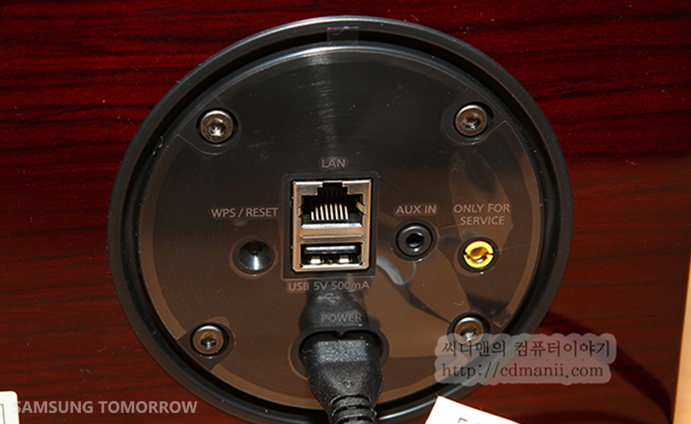
Now that we’ve examined each component of the device, let's connect a smartphone. First, click on the dock with the inscription "PUSH", after which it extends from the hull. Having connected the smartphone, we raise the guide "back" to conveniently and reliably place it on the dock. You can download the Samsung Wireless Audio Dock for GALAXY Series smartphones from the Play Store to automatically connect your device with a dock via Bluetooth. However, the connection process may take some time. In my opinion, pressing the connect button via Bluetooth will be faster.

Since I use GALAXY S III, I connected the phone to the first connector and then lifted the black support cover (if you lift the support cover in the first place, then it will be extremely inconvenient to connect the phone).
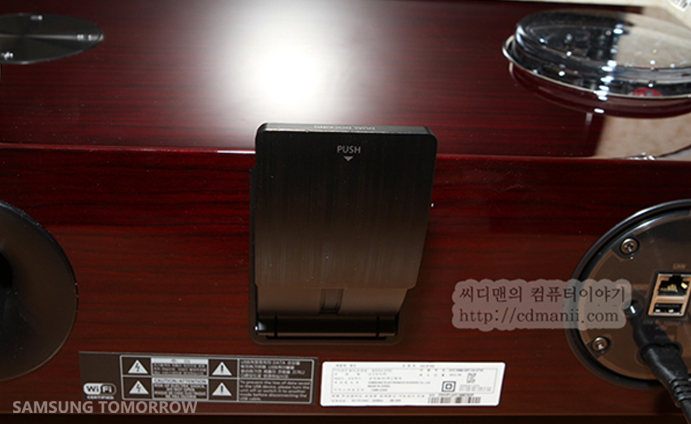
In addition, the connector is flexible and can move back and forth. The developers have made it flexible in order to avoid damage to the device when inaccurate connection.
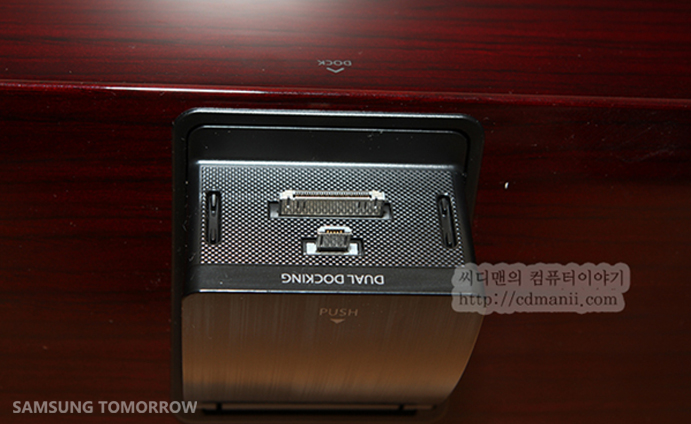
This is how the supporting part of the dock looks after connecting a smartphone to it. As I mentioned earlier, GALAXY series devices can be charged through this connector, and it is easier to play music via Bluetooth.
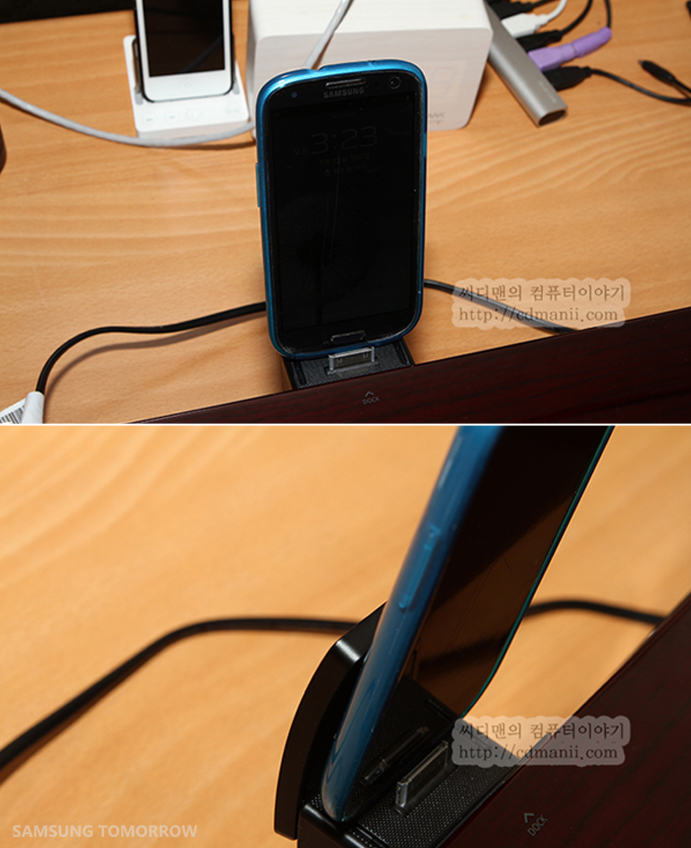
After connecting, widgets for battery status, time and weather were displayed. To play music, you must first run the corresponding application and connect through it to the music player or YouTube. A little saddened by the fact that it will not open automatically immediately after connecting.
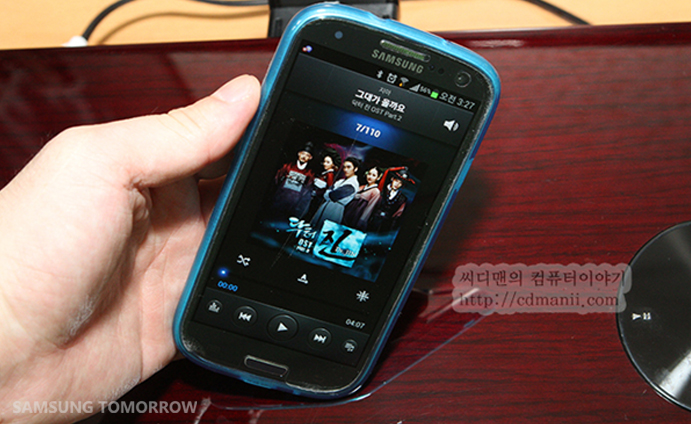
If you turn off the phone while playing music, it will pause. This is easy to fix - just press PLAY again and the music will start playing through the Bluetooth connection again. Later, Samsung will fix this in such a way that music playback will not be interrupted when the smartphone is turned off.
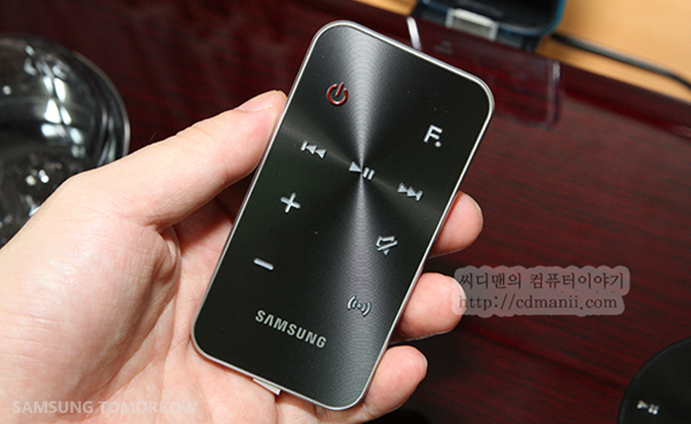
What would this device be without the ability to control air? Of course, the DA-E750 plays music on its own, and other functions can be controlled from the device. But the big inconvenience is that the volume level on the dock is not displayed, so you have to adjust it by ear. You can control the volume from the phone, but on the GALAXY S III the volume level is not interconnected with the volume level of the dock itself (on iPhone, the volume level of the dock directly depends on the settings on the smartphone itself). As a result, even if the volume level of the sound on the smartphone is at the lowest level, the volume of the device itself may remain at maximum.

I was able to easily connect the iPhone (even with the support cover raised, the 30-pin port was easily accessible).
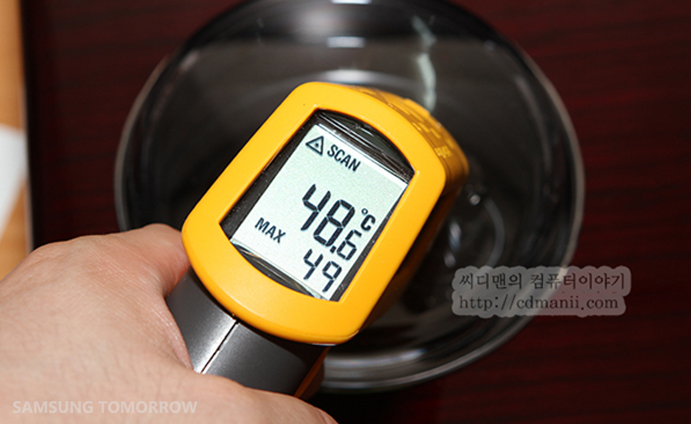
I measured the temperature of the vacuum tubes to see how much the device heats up after prolonged use. The temperature was about 49 degrees Celsius. The device, of course, will not light up, but it should be noted that it decently heats up.

It took me a while to measure the power consumption of the DA-E750 in standby mode. In the off state, the indicator of power consumption was only 0.226W, while on - 15.05W.
As far as I know, there is no power saving mode for the docking station. If you accidentally leave the audio system turned on, it’s just how much power it will consume. To make sure that the device is turned on, you can only look at the vacuum tubes, so it would be nice if in the future the developers added an energy-saving mode. However, for the best sound quality, the vacuum tubes really need to be preheated, so that with frequent listening, the device in any case will need to be left on for a long time. In general, it all depends on how often and long you plan to use the device.
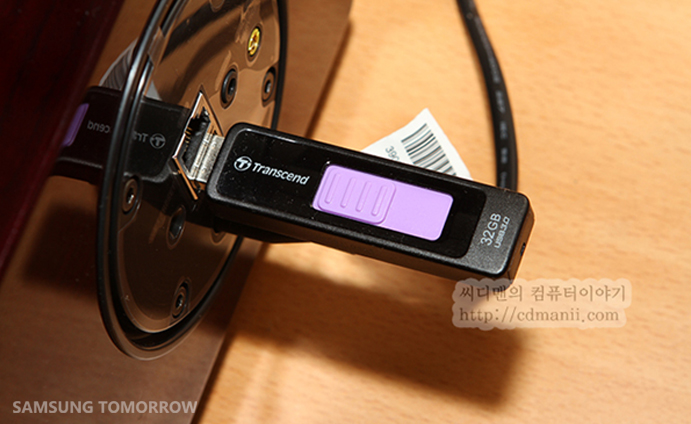
Finally, I checked the connection to the USB port to make sure that it works. Music from a USB stick is well recognized and plays smoothly. But I want to warn you: the dock did not recognize my external hard drive.

The opportunity to study the Samsung DA-E750 in such depths helped me see both its strengths and weaknesses. Support for connections with various devices is a big plus. But I must admit that I had to press the WPS button several times during the initial connection, which led me to the conclusion: it would be nice to have a separate button for this on the remote control. The sound quality is really at its best, but the music volume during the first connection of the GALAXY S Ⅲ was too high. Of course, everyone has their own preferences, but it somewhat discouraged me. I hope that in the future these details will be better developed for even greater user convenience. On a final positive note, I would like to say that the audio system looks very stylish and elegant, with a touch of modern retro, which I personally really liked. I hope my review has been interesting and gave you a deeper understanding of the Samsung DA-E750.
Specifications
Today I would like to bring to your attention an overview of the new Samsung DA-E750 wireless audio system. The flagship novelty was studied up and down by the Korean blogger CD Man.

If you can relate to music lovers and audiophiles, you must have heard about the new Samsung DA-E750 audio system. This device marks Samsung’s expansion into the hi-end audio market, combining high-quality sound and aesthetically pleasing design.

DA-E750 is a wireless audio dock that is equipped with vacuum tubes and can connect to smartphones (supports iPhone, iPad, iPod and all smartphones of the GALAXY series). Being the proud owner of the GALAXY S III, I had the opportunity to connect to the dock via a Bluetooth connection. The device supports various communication interfaces, such as USB, Air Play, Allshare Play and Bluetooth, so you do not have to worry, even if your smartphone is not from the GALAXY series.
If you prefer an iPhone or iPad, you can connect them to the DA-E750 through the port or via Air Play for a wireless connection.
I want to share with you my thoughts on the new Samsung audio system, which I have carefully tested. I will talk about the strengths and weaknesses so that you can get a complete picture of what this equipment is capable of.
The DA-E750 looks like a rectangular block, with two large and two small front speakers. Through a transparent glass cover in the upper left you can see two vacuum lamps and a round control panel on the right. The weight of the device is 8.6 kg.

A camera flash makes the colors a little brighter than they really are, so in reality the tree has a dark reddish brown hue. The surface of the classic case is varnished and smooth.

Wanting to learn more about the audio system, I decided to check the sound quality of the dock itself.
To check the sound quality, I connected the device directly via USB, and at first the sound was not as good as I expected. For comfortable listening to music, you need not only decent speakers, but also a good sound source. But it seems that the DA-E750 needs a little time to preheat until it starts to produce the perfect sound. This happened after some time: the sound became excellent.

Next, I noticed the vacuum tubes at the top. When turned on, they turn red, as you can see in the photo. The input signal source is processed by a preliminary amplification stage performed on two ECC83 lamps, and then passes through a power amplifier operating in class D. It is stated that the service life of these vacuum tubes will be quite long.

At the top left is the control panel. To show all the icons in the photo, I clicked on it. At rest, the icons do not light. Pressing the play button turns on the device, a long press on it also turns off the power. Through the panel, you can control playback, pause, volume control and a choice of functions.
A small disappointment was the fact that looking at the front panel of the system it is impossible to determine whether the device is turned on or not. I think the presence of the function to automatically turn off the dock at a time when it is inactive would be very helpful here.
In addition, the “skip to next song” function was not available on the control panel. Of course, you can use a smartphone or a remote control to select the next song, but I think it would be nice to add these buttons: not that there isn’t enough room for them. I would also like to be able to see the volume level on the device itself. I was frightened almost to hiccups when I first connected my phone to the audio system via Bluetooth. The sound just dumbfounded me, because it was initially set to maximum volume. It would not be superfluous to have an automatic reset of the playback volume the first time you turn it on.
Now let's look at the bottom of the Samsung DA-E750. This is where the subwoofer is located, as well as sharp conical legs with rubber pads.

There are not many elements on the rear panel of the device, this also applies to the number of ports. The phase inverter port is displayed on the left side, the LAN port, USB port, AUX IN and various connection interfaces are on the right, and in the middle is the dock.

There is also a WPS / Reset button that provides a quick connection, an ONLY FOR SERVICE service port, and a power connector.

Now that we’ve examined each component of the device, let's connect a smartphone. First, click on the dock with the inscription "PUSH", after which it extends from the hull. Having connected the smartphone, we raise the guide "back" to conveniently and reliably place it on the dock. You can download the Samsung Wireless Audio Dock for GALAXY Series smartphones from the Play Store to automatically connect your device with a dock via Bluetooth. However, the connection process may take some time. In my opinion, pressing the connect button via Bluetooth will be faster.

Since I use GALAXY S III, I connected the phone to the first connector and then lifted the black support cover (if you lift the support cover in the first place, then it will be extremely inconvenient to connect the phone).

In addition, the connector is flexible and can move back and forth. The developers have made it flexible in order to avoid damage to the device when inaccurate connection.

This is how the supporting part of the dock looks after connecting a smartphone to it. As I mentioned earlier, GALAXY series devices can be charged through this connector, and it is easier to play music via Bluetooth.

After connecting, widgets for battery status, time and weather were displayed. To play music, you must first run the corresponding application and connect through it to the music player or YouTube. A little saddened by the fact that it will not open automatically immediately after connecting.

If you turn off the phone while playing music, it will pause. This is easy to fix - just press PLAY again and the music will start playing through the Bluetooth connection again. Later, Samsung will fix this in such a way that music playback will not be interrupted when the smartphone is turned off.

What would this device be without the ability to control air? Of course, the DA-E750 plays music on its own, and other functions can be controlled from the device. But the big inconvenience is that the volume level on the dock is not displayed, so you have to adjust it by ear. You can control the volume from the phone, but on the GALAXY S III the volume level is not interconnected with the volume level of the dock itself (on iPhone, the volume level of the dock directly depends on the settings on the smartphone itself). As a result, even if the volume level of the sound on the smartphone is at the lowest level, the volume of the device itself may remain at maximum.

I was able to easily connect the iPhone (even with the support cover raised, the 30-pin port was easily accessible).

I measured the temperature of the vacuum tubes to see how much the device heats up after prolonged use. The temperature was about 49 degrees Celsius. The device, of course, will not light up, but it should be noted that it decently heats up.

It took me a while to measure the power consumption of the DA-E750 in standby mode. In the off state, the indicator of power consumption was only 0.226W, while on - 15.05W.
As far as I know, there is no power saving mode for the docking station. If you accidentally leave the audio system turned on, it’s just how much power it will consume. To make sure that the device is turned on, you can only look at the vacuum tubes, so it would be nice if in the future the developers added an energy-saving mode. However, for the best sound quality, the vacuum tubes really need to be preheated, so that with frequent listening, the device in any case will need to be left on for a long time. In general, it all depends on how often and long you plan to use the device.

Finally, I checked the connection to the USB port to make sure that it works. Music from a USB stick is well recognized and plays smoothly. But I want to warn you: the dock did not recognize my external hard drive.

The opportunity to study the Samsung DA-E750 in such depths helped me see both its strengths and weaknesses. Support for connections with various devices is a big plus. But I must admit that I had to press the WPS button several times during the initial connection, which led me to the conclusion: it would be nice to have a separate button for this on the remote control. The sound quality is really at its best, but the music volume during the first connection of the GALAXY S Ⅲ was too high. Of course, everyone has their own preferences, but it somewhat discouraged me. I hope that in the future these details will be better developed for even greater user convenience. On a final positive note, I would like to say that the audio system looks very stylish and elegant, with a touch of modern retro, which I personally really liked. I hope my review has been interesting and gave you a deeper understanding of the Samsung DA-E750.
Specifications
